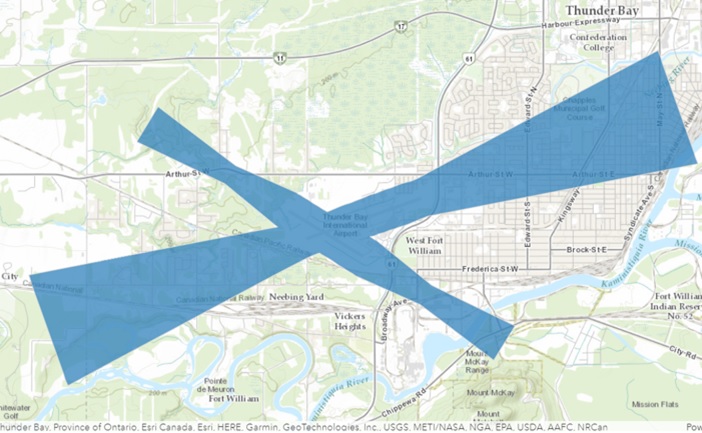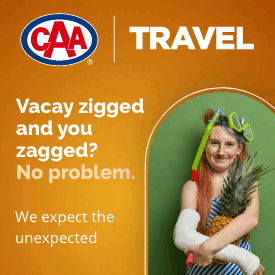Permit Applications
TBIAAI manages several Permit process for work both on Airport lands and in critical airspace within 4KM of the aerodrome centre to authorize, track, monitor, record construction and ensure that it satisfies TBIAAI standards. TBIAAI is the Landlord of the Thunder Bay International Airport. Throughout the permitting and construction process, TBIAAI's Permits Coordinator or an assigned Project Manager will represent the Landlord.
In addition to TBIAAI FAP permits, processes exist for other jurisdictions having authority that may require a permit application to be submitted. Contact the TBIAAI if you are unsure whether any of those permits are applicable for your project.
TBIAAI has established a fee structure applicable to projects that require TBIAAI project management and oversight where aviation safety and regulatory compliance are affected. Upon review of the completed applicable application, the applicant will be advised of the appropriate fees that may be associated to the project.
Fees associated with TBIAAI Project Management of FAP projects.
TBIAAI Facility Alteration Permit (FAP)
https://yqt.vortexcms.com/facility-alteration-permit-application
This form must be completed for any project that alters any existing facilitiy planned to occur in any buildings on airport property by any tenant or airline. This process applies regardless of who owns the facility.
Assessment for Crane Operations
https://yqt.vortexcms.com/temporary-crane-assessment
This form must be completed in advance of any project that involves the use of a boom truck, elevated lift device, or any type of crane being lifted around the airport property. This applies to any crane within the City of Thunder Bay within a 4 (four) kilometer radius of the airport. This process must be completed in advance of the crane project, and also approved by the TBIAAI - who has authority under the Aeronautics Aact to apporve or decline crane lifts within the footprint area shown i nthe map below. This process is correlated with the City of Thunder Bay building permit application process.
This form assists the TBIAAI with assessing airport Obstacle Limitation Surface (OLS) or Obstacle Identification Surface (OIS) for all construction projects outside airport property within a 4KM radius form the airport reference point.

Dig (excavation) Permit Application
Please read TBIAAI's Excavation Guidelines here.
https://yqt.vortexcms.com/dig-permit-application
This form is required for any project or planned activity that requires ground excavation on airport property. The processes in the form allow TBIAAI to ensure that the protection of the vast underground airport network is protected at all costs. Final approved permits must be printed and kept on site at the location of the excavation at all times, and no digging is permitted without an approved permit.
Building Permit Application
https://yqt.vortexcms.com/building-permit-application
This form is required for all NEW building construction, or any construction that includes the addition of any new facility build on airport property. Due to the complexities of what is involved in all new builds, it may be necessary to complete multiple permit applications, depending on the nature of the construction. For more information contact a TBIAAI representative.
Special Event Permit Application
https://yqt.vortexcms.com/special-events-permit
This Application is for parties seeking permission from the Thunder Bay International Airports Authority to host an event on the airport lands. All applicants must seek permission from the Authority before hosting any event on airport lands by completing and submitting this application. The applicant must agree to the terms and conditions contained in the permit.
NOTE: Flying of unmanned air vehicles (UAVs) or drones are NOT PERMITTED within 5.6 km of the airport without express written permission from the TBIAAI in accordance with the TBIAAI RPAS Management Plan.
OTHER APPLICABLE PROCESSES: The following Regulated processes may be applicable to your project, and are owned by parties other than the TBIAAI.
The City Of Thunder Bay (Municipal building permit and zoning compliance)
Building permits are subject to "applicable law." Proposals that do not follow applicable law will not receive a building permit. These proposals may need to go through more processes to become permitted. For example, if your proposed use for your building is not permitted by the Zoning By-law, you will require a Zoning By-law Amendment through Planning Services. This can extend timelines and increase costs. Consulting with the City ahead of time can help you avoid these extra processes or help you plan for them early.
City of Thunder Bay Building Height Restricted Area Feature Layer (Open Data Portal)
Transport Canada (Obstacle review and AZR compliance)
When is an object an obstacle?
According to the Canadian Aviation Regulations (CARs) 601.23 an object is an obstacle if:
- higher than 90 meters above ground level (AGL) and located within 6 kilometers of the geographical centre of an aerodrome
- higher than 90 meters AGL and is located within 3.7 kilometers of the centreline of a recognized VFR route
- higher than 150 meters AGL
- in the case of any catenary wires crossing over a river, any portion of the wires or supporting structures is higher than 90 m AGL
- An object may also be an obstacle if it penetrates an airport Obstacle Limitation Surface (OLS) or Obstacle Identification Surface (OIS) as detailed in Aerodrome Standards and Recommended Practices (TP 312). Further, an object may also be deemed an obstacle, if so determined by Transport Canada. Refer to CAR 601.25.
Putting up an object?
If you are putting up an object that will be an obstacle, you must:
- notify the Regional office of Transport Canada by filing the Aeronautical Assessment Form for Obstacle Evaluation for obstruction marking and lighting (PDF, 784 KB)
- notify NAV CANADA's Land Use Program, primarily for communication and radar interference concerns
- mark and light the object in accordance with the requirements of Standard 621
- a notification is required to Transport Canada Marine Administration when the object is to be located offshore or on navigable waterways.
Aeronautical Assessment Form for Obstacle Evaluation
Reference: Standard 621 - Obstruction Marking and Lighting - Canadian Aviation Regulations (CARs)
NavCanada (Obstacle review and aeronautical interference compliance)
NAV CANADA assesses all land use proposals near airports and air navigation infrastructure before construction begins to ensure that safety and efficiency are not compromised. Some development uses may not be permitted even if other permits have been obtained.
As soon as you start to conceptualize or plan a project, contact our Land Use Office. Consulting with the Land Use Office often reveals issues that need to be addressed. Aviation-specific regulations, operational, and safety standards may significantly impact a project.
Toll-free number: 1 800 876 4693
General Enquiries Email: service@navcanada.ca
Land Use Proposal Submissions: landuse@navcanada.ca


